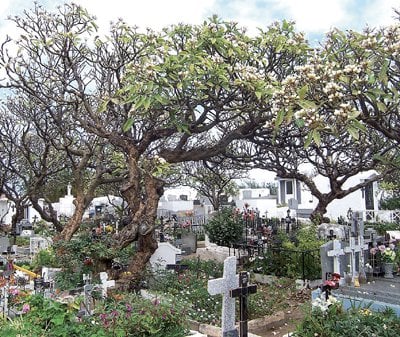Phuket Gardening: Blooming plumerias

PHUKET: In an email both quirky and perceptive, a fellow contributor to the Phuket Gazette recently confessed to dealing with Phuket’s 35 degree heat by gardening at night, and thereby, and unsurprisingly, incurring the curiosity of his neighbors. Personally I haven’t tried it.
But, I entirely concur with his subsequent reasoning that because the island’s soil is so difficult to work and so impoverished, it helps to explain why locals use so many pots. In this way, they can control the conditions (for example, by using better quality soil or moving pots around) in which their container plants can flourish.
Of plants that can cope with Phuket’s clay marl, our e-mailer singled out two, of which one was the plumeria or frangipani (the other was bamboo), giving me an excuse to laud its virtues in print.
Yes, the plumeria is a real toughie, putting up with dry as well as semi-arid conditions underfoot. And although it is another American native, it has adapted to life in the tropical fast-lane everywhere in South East Asia.
Let’s pursue a metaphor for a moment. Take the Chalong motorway to nowhere (actually Rawai), take one of the signed turnings left off Wichit Road, and near the sea you will find a Muslim cemetery decked out with numerous graceful, white-blossoming plumerias, trees which seem to flower all year round with little if any attention
Coincidentally, the reason why Thais are sometimes reluctant to cultivate this shrub is because of its association with graveyards. They have even changed the old-fashioned name of lam–tom, a word redolent of sadness, to the bright and breezy sounding leelawadee.
But for your “farang” garden, the leelawadee is a must. It has an exquisite scent, and the flowers are borne in dense clusters which may contain as many as a hundred blooms. They are initially tubular in appearance, but expand into a “pinwheel” of five petals that average two to three inches in diameter, Most commonly white, or pink, the blooms may also be red, yellow or, in the case of some hybrids, possess multiple colors.
The large leaves, which grow mostly near the ends of branches, are usually glossy green, but may be a dull green; they are generally ovate, but may be blunt-tipped (obtusa) or pointed (rubra). Obtusa cultivars tend to retain their foliage all year round, while the deciduous types drop their leaves for part of the year, giving the shrub a rather forlorn appearance.
Plumerias can be produce by seed, but they are better grown from cuttings. Like many members of the apocynaceae family, cuttings, which should be one foot or more in length, produce a milky sap which is toxic, and can irritate the skin. As with euphorbias, it is best to allow the cut end to dry out or ‘cure’ for up to two weeks before inserting it in potting mix or barely moist soil. Do not over-water while the cutting is taking root, otherwise it will rot. Quick growers, established plumerias can reach ten to twelve feet in six years, given adequate fertilizer (an ideal blend is 10-30-10 ) and moderate moisture. It is a common practice among commercial growers, who use the flowers for leis(garlands), to prune the canopy in order to keep it low, and to encourage branching and flowering.
Left to its own devices, most varieties will develop an open crown with relatively few branches. Ideal if you want to grow smaller plants in its sparse shadow.
Oh, and by the way, you don’t have to plant your plumeria cuttings by the light of the moon….
Tip of the week – biennials
Biennials typically complete their life-cycle in two years. During their first year they grow from seed into leafy, but non-blooming plants. However, those grown in nurseries usually flower and set seed the same year.
Normally biennials need a cool period, so there are relatively few in the tropics. Echium pininana, which produces tall rosettes of long leaves followed by blue flowers is one that will grow here.
Bulbs have specialized roots or stem bases that store nutrients and energy for the plant’s growth. Choose bulbs that are plump and firm (as with onions).
In most soils, true bulbs and corms should be planted about three times as deep as the bulb is wide. They will need water while they are actively growing. For most, growth begins after planting and continues until the flowers or foliage dies back. Use a nitrogen-rich fertilizer to replenish depleted nutrients.
Phuket Gardening is Gazette columnist Patrick Campbell’s feature of all things flora.
If you have a question or a garden that you would like featured, you can email Patrick Campbell here.
Keep checking our online Phuket Lifestyle pages for regular gardening features and tips
— Patrick Campbell
Latest Thailand News
Follow The Thaiger on Google News:


























